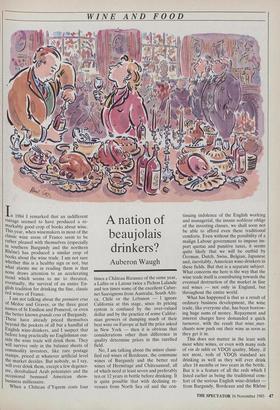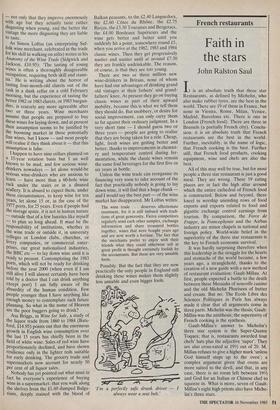WINE AND FOOD
I am not talking about the premiers crus of Medoc and Graves, or the three great names of St Emilion and Pomerol, or even the better known Brands crus of Burgundy. These have already priced themselves beyond the pockets of all but a handful of English wine-drinkers, and I suspect that before long practically no Englishman out- side the wine trade will drink them. They will survive only in the balance sheets of commodity investors, like rare postage stamps, priced at whatever artificial level the market decides. But nobody, as I say, will ever drink them, except a few degener- ate, detribalised Arab potentates and the occasional bemused American show- business millionaire.
When a Chateau d'Yquem costs four
A nation of beauj olais drinkers?
Auberon Waugh
times a Chateau Rieussec of the same year, a Lafite or a Latour twice a Pichon Lalande and ten times some of the excellent Caber- net Sauvignons from Australia, South Afri- ca, Chile or the Lebanon — I ignore California at this stage, since its pricing system is confused by the over-valued dollar and by the practice of some Califor- nian growers of dumping much of their best wine on Europe at half the price asked in New York — then it is obvious that considerations other than difference in quality determine prices in this rarefied field.
No, I am talking about the minor classi- fied red wines of Bordeaux, the commune wines of Burgundy and the better red wines of Hermitage and Chateauneuf, all of which need at least seven and preferably ten or 12 years in bottle before drinking. It is quite possible that with declining re- venues from North Sea oil and the con- tinuing indolence of the English working and managerial, the insane noblesse oblige of the investing classes, we shall soon not be able to afford even these traditional comforts. Even without the possibility of a malign Labour government to impose im- port quotas and punitive taxes, it seems quite likely that we will be outbid by German, Dutch, Swiss, Belgian, Japanese and, inevitably, American wine-drinkers in these fields. But that is a separate subject. What concerns me here is the way that the wine trade itself is contributing towards the eventual destruction of the market in fine red wines — not only in England, but throughout the entire world.
What has happened is that as a result of ordinary business development, the wine trade, like everyone else, has been borrow- ing huge sums of money. Repayment and interest charges have demanded a quick turnover, with the result that wine ,mer- chants now push out their wine as soon as they get it in.
This does not matter in the least with most white wines, or even with many reds of yin de table or VDQS quality. Many, if not most, reds of VDQS standard are drinking as well as they will ever drink after 18 months or two years in the bottle. But it is a feature of all the reds which I listed earlier as being the traditional com- fort of the serious English wine-drinker from Burgundy, Bordeaux and the Rhone
not only that they improve enormously with age but they actually taste rather disgusting when young, and the better the vintage the more disgusting they are liable to taste.
As Simon Loftus (an enterprising Suf- folk wine merchant, celebrated in the trade for his skill in walking on stilts) writes in his Anatomy of the Wine Trade (Sidgwick and Jackson, £10.95): 'The tasting of young wines is often a thoroughly disagreeable occupation, requiring both skill and stami- na.' He is writing about the horror of tasting four-month-old clarets out of the cask in a dank cellar on a cold February morning, but the experience of tasting the better 1982 or 1983 clarets, or 1983 burgun- dies, is scarcely any more agreeable after two or three years. Wine merchants assume that people are prepared to buy these wines for laying down, and at present their assumption seems to be justified by the booming market in these potentially fine wines, but I know — and most people will realise if they think about it — that this assumption is false. I happen to have nine cellars planned on a 15-year rotation basis but I an well known to be mad, and few serious wine- drinkers nowadays — let alone would-be serious wine-drinkers who are anxious to learn — have more than a 60-hole wine rack under the stairs or in a disused scullery. It is absurd to expect them, under these circumstances, to keep wine for ten years, let alone 15 or, in the case of the 1977 ports, for 25 years. Even if people had the storage space, it is not in human nature
outside that of a few lunatics like myself
to plan so long ahead. It must be the responsibility of institutions, whether in the wine trade or outside it, in university colleges or London clubs, churches, or livery companies, or commercial enter- prises, our great nationalised industries, the BBC etc — to lay down wine until it is ready to present. Contemplating the 1983 Ports, which will not be ready for drinking before the year 2000 (when even if I am still alive I will almost certainly have been told by a doctor that I can drink anything except port) I am fully aware of the absurdity of the human condition. Few People younger than I have anything like enough money to contemplate such future planning. So what in the name of Heaven are the poor buggers going to drink? Asa Briggs, in Wine for Sale, a study of the liquor trade from 1860 to 1984 (Bats- ford, £14.95) points out that the enormous growth in English wine consumption over the last 15 years has chiefly been in the field of white wine. Sales of red wine have proportionately declined, and have shown resilience only in the lighter reds suitable for early drinking. The grocery trade and supermarkets now account for nearly 50 per cent of all liquor sales.
Nobody has yet pointed out what must in fact be everyone's experience of buying wine in a supermarket: that you walk along the shelves from the £1.60 dumped Bulga- rians, deeply stained with the blood of Balkan peasants, to the £2.40 Languedocs, the £2.60 Cotes du Rhone, the £2.75 Riojas, the £3.50 Touraines and Bergeracs, the £4.00 Bordeaux Superieurs and the wine gets better and better until you suddenly hit a point, somewhere round £5, when you arrive at the 1982, 1983 and 1984 classic wines. Then they get progressively nastier and nastier until at around £7.50 they are frankly undrinkable. The reason, of course, is that they are too young. There are two or three million new wine-drinkers in Britain, none of whom have had our advantages of drinking grand old vintages at their fathers' and grand- fathers' knee. At present they go on buying classic wines as part of their upward mobility, because this is what we tell' them they should do. But snobbery, or desire for social improvement, can only carry them so far against their ordinary judgment. In a very short time — I should guess two or three years — people are going to realise that they are being taken for a ride. Cheap, light, fresh wines are getting better and better, thanks to improvements in chemist- ry and temperature control during fer- mentation, while the classic wines remain the same foul beverages for the first five or six years in bottle. Unless the wine trade can reorganise its financing very soon to take account of the fact that practically nobody is going to lay down wine, it will find that a huge chunk and I would say the best part — of the wine market has disappeared. Mr Loftus writes: The wine trade . . . deserves affectionate treatment, for it is still imbued with tradi- tions of great generosity. Fierce competitors regularly send each other samples, exchange information and share treasured bottles together, wines that were bought years ago and are now worth a fortune. The fact that the merchants prefer to enjoy with their friends what they could otherwise sell at great profit is thought extremely foolish by the accountants. But these are very amiable fools.
Possibly. But the fact that they are now practically the only people in England still drinking these wines makes them slightly less amiable and even bigger fools.
'I'm a perfectly safe drunk driver — I always wear a seat belt.'



































































 Previous page
Previous page